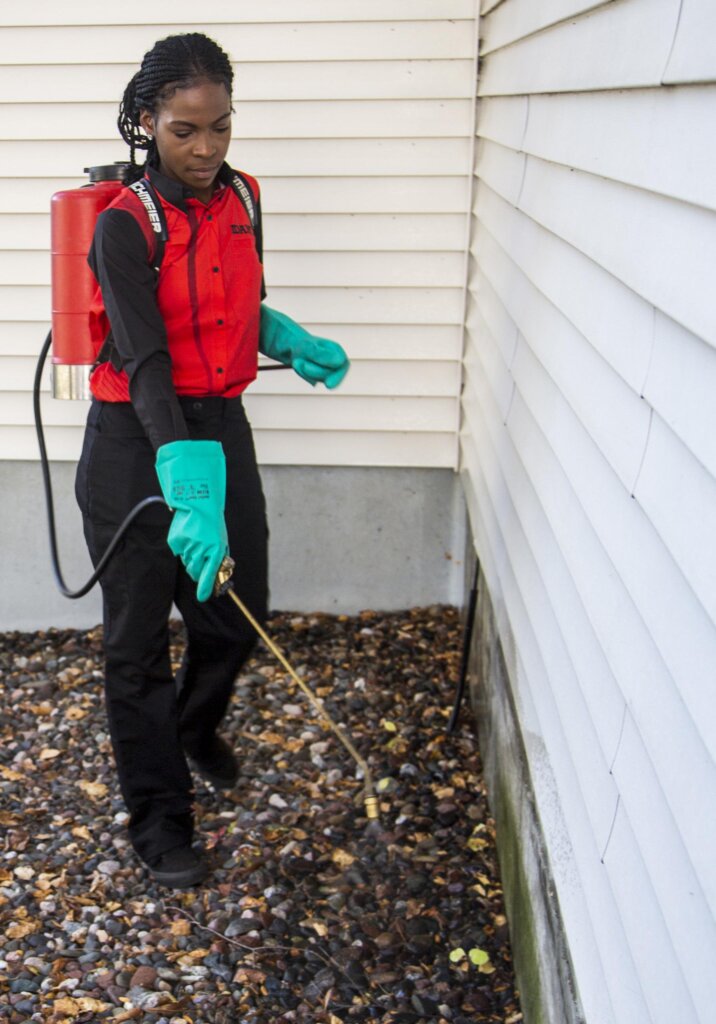Experienced A1 Exterminators Charlotte NC - Fast and Dependable Solutions
Experienced A1 Exterminators Charlotte NC - Fast and Dependable Solutions
Blog Article
Bed Bug Treatment Failure: Contrasting Chemical Vs. Non-Chemical Solutions
In the world of pest control, specifically when handling the consistent problem of bed pests, the option between chemical and non-chemical treatment services can be a pivotal one. Both strategies supply unique advantages and disadvantages, influencing variables such as efficiency, safety factors to consider, and total price. By taking a look at the nuanced information of each method, a more clear understanding of which course to pursue in attending to a bed insect problem can be achieved.
Efficiency of Chemical Therapies
Chemical therapies for bed pest invasions have actually been extensively acknowledged for their powerful and fast efficacy in eradicating these pests. When considering the effectiveness of chemical therapies, it is crucial to recognize that they can supply a fast and comprehensive solution to a bed pest issue.
Moreover, chemical treatments have the advantage of offering residual impacts, meaning that they can remain to remove bed pests even after the preliminary application. This residual action is particularly beneficial in combating any kind of prospective re-infestations. Additionally, the fast activity of chemical therapies can bring relief to individuals encountering extreme bed pest invasions, permitting them to regain control of their home quickly.
Safety Issues With Chemical Solutions
One vital facet that calls for cautious consideration when making use of chemical options for bed insect therapy is guaranteeing the security of owners and the atmosphere. Exposure to certain chemicals made use of in bed pest treatments can lead to respiratory system problems, skin irritability, or other unfavorable reactions, especially in individuals with pre-existing conditions or level of sensitivities.
Additionally, the environmental influence of chemical remedies is another considerable consideration. Some pesticides made use of in bed bug therapies may be unsafe to valuable pests, wild animals, and environments if they seep right into the soil or water supply. It is vital to make use of chemical treatments carefully, adhering to safety and security guidelines, and taking into consideration less poisonous options to reduce these risks and guarantee the safe and reliable administration of bed bug invasions.
Benefits of Non-Chemical Methods
Considering the possible security worries and environmental effect linked with chemical services for bed bug therapy, exploring non-chemical techniques presents an encouraging choice with a number of distinctive benefits. Non-chemical techniques offer a more secure option for households, especially those with children, people, or animals conscious severe chemicals. These techniques eliminate the risks of direct exposure to toxic compounds, decreasing the possibility for unfavorable health results. Additionally, non-chemical therapies are eco-friendly, as they do not add to air or water pollution, making them a sustainable choice for parasite control.
Additionally, non-chemical solutions can be efficient in targeting bed pests, including hard-to-reach locations where chemical treatments might not penetrate. Methods such as heat therapy, vacuuming, vapor cleaning, and cushion encasements offer detailed removal without using damaging chemicals. Moreover, non-chemical strategies can be less turbulent, requiring marginal preparation and enabling quicker reentry into dealt with locations. On the whole, going with non-chemical bed find out here now insect treatment approaches not just focuses on safety and security and environmental protection but also makes sure efficient and comprehensive insect control.
Limitations of Non-Chemical Treatments

Furthermore, non-chemical treatments often need several applications to achieve effective obliteration. This can be taxing and might not always assure full elimination of all bed pests and their eggs, especially in surprise or hard-to-reach places.
In addition, the success of non-chemical treatments greatly relies on proper implementation and thoroughness, which can be challenging for individuals without professional proficiency. Insufficient application of non-chemical techniques may lead to incomplete elimination, resulting in consistent infestations and the requirement for added treatments.
Consequently, while non-chemical therapies have their benefits, it is vital to recognize these constraints and consider them when establishing the most reliable strategy for taking care of bed insect invasions.
Expense Comparison: Chemical Vs. Non-Chemical Options
Given the restrictions linked with non-chemical treatments, a necessary aspect to review in the context of bed insect management is the expense comparison between chemical and non-chemical options. In contrast, non-chemical treatments like warm treatment or steam can be more costly, with costs varying from $1,000 to $6,000 for a whole home. While the first cost of chemical therapies might appear reduced, numerous treatments might be called for to fully remove the over at this website invasion, potentially raising the overall expense.
Conclusion

Considering the potential safety and security concerns and environmental effect linked with chemical services for bed pest therapy, checking out non-chemical approaches provides an appealing option with a number of unique benefits.Offered the restrictions linked with non-chemical therapies, a vital facet to examine More Help in the context of bed insect management is the price contrast between chemical and non-chemical choices. In contrast, non-chemical treatments like warmth therapy or steam can be a lot more costly, with expenses varying from $1,000 to $6,000 for a whole home. While the first price of chemical treatments might seem reduced, multiple therapies might be required to totally eliminate the infestation, potentially boosting the total expense.In verdict, when comparing chemical and non-chemical bed insect therapy alternatives, it is crucial to consider performance, security, benefits, restrictions, and price.
Report this page